
Our Services
for adults and children
Our Services
for adults and children
Implantology
For a firm bite and a carefree laugh
The All-on-4® / All-on-6® concept of the so-called immediate restoration was developed in order to offer toothless patients a fast and firmly seated complete prosthetic restoration. No period of toothlessness and a poorly fitting, wobbly temporary restoration are to be expected - as a rule, the implantation and the restoration with a fixed temporary restoration can be carried out within one to two days. In the upper jaw, this procedure often eliminates the need to build up the maxillary sinus bone.
Conventional dental implants take several weeks to months to heal. Only then is the final denture applied and the implants can be loaded.
All-on-4 ® / All-on-6 ® is suitable for almost all edentulous patients - even for patients who are already suffering from a receding jawbone. Nevertheless, it can happen from time to time that we cannot offer this method to a patient - for example, if the bone loss is particularly pronounced. Please also note that the preservation of your own teeth should always be in the foreground. Ultimately, this can only be clarified by a comprehensive preliminary examination at our office in Himmelmann and colleagues.
Mini implants are small one-piece Titanium pins or titanium alloys of small size of only 1,8-2,4 mm Diameter. These little ones Dental implants serve for the secure fixation and stabilization of the "third teeth", mostly of full dentures in the toothless upper and lower jaw.
Most prosthesis wearers know that their quality of life is limited by poorly fitting, wobbly prostheses, and often too painful pressure points in the mouth cause.
Frequent visits to the dentist or the dental laboratory to reline the dentures are necessary, the daily use of bad-tasting adhesive creams is only an emergency solution.
More serious, however, have an impact ill-fitting prostheses on the jawbone. Due to the toothlessness or the incorrect prosthesis, the Chewing forces are no longer transferred to the bone, which reacts to the lack of “stimulus” with a decrease in bone volume.
As a result, the necessary support function through bones and teeth is missing in the long term, the face shape changes, the face collapses, the prosthesis fits even worse.
To stop or prevent this process, mini-implants are an ideal solution and are used by many Implantologists preferably used.
Like conventional implants, mini-implants replace the lost natural tooth roots and have similar properties to these. Because they can transmit the chewing forces to the jawbone, thus stop bone decline and give dentures a secure hold.
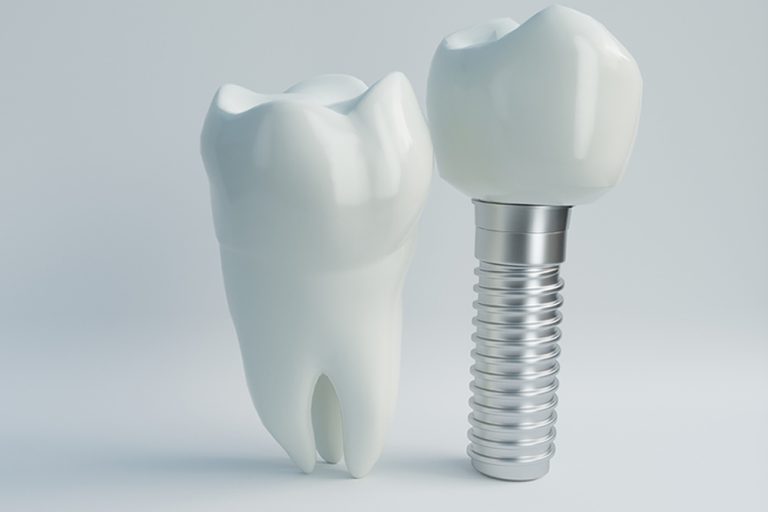
Implantology
For a firm bite and a carefree laugh
The teeth are not only important for the intake of food, but also crucial for speaking, laughing and shaping the facial features and the overall appearance of a person.
For example, the loss of a single tooth can seriously affect its appearance, but above all it can also trigger malfunctions in the chewing system, with pathogenic effects on the whole body.
Clinical experience in dental implantology from almost 40 years shows that over 90% of dental implants fulfill their function as new tooth roots in the long term. They sustainably improve the quality of life of patients by restoring function and aesthetics.
A great advantage is the versatility of implantology, because it is suitable for replacing individual teeth, solving free-end situations or providing stable restorations for toothless jaws.
Various implant concepts are used here, which enable fixed prostheses or removable dentures to be placed on the implants.
A major advantage over dental bridges is that no teeth have to be ground, so the tooth substance is preserved. In addition, dental implants prevent the dreaded bone loss in the jaw, as they are comparable to the biomechanical properties of natural tooth roots and thus stimulate bone formation.
The All-on-4® / All-on-6® concept of the so-called immediate restoration was developed in order to offer toothless patients a fast and firmly seated complete prosthetic restoration. No period of toothlessness and a poorly fitting, wobbly temporary restoration are to be expected - as a rule, the implantation and the restoration with a fixed temporary restoration can be carried out within one to two days. In the upper jaw, this procedure often eliminates the need to build up the maxillary sinus bone.
Conventional dental implants take several weeks to months to heal. Only then is the final denture applied and the implants can be loaded.
All-on-4 ® / All-on-6 ® is suitable for almost all edentulous patients - even for patients who are already suffering from a receding jawbone. Nevertheless, it can happen from time to time that we cannot offer this method to a patient - for example, if the bone loss is particularly pronounced. Please also note that the preservation of your own teeth should always be in the foreground. Ultimately, this can only be clarified by a comprehensive preliminary examination at our office in Himmelmann and colleagues.
Mini implants are small one-piece Titanium pins or titanium alloys of small size of only 1,8-2,4 mm Diameter. These little ones Dental implants serve for the secure fixation and stabilization of the "third teeth", mostly of full dentures in the toothless upper and lower jaw.
Most prosthesis wearers know that their quality of life is limited by poorly fitting, wobbly prostheses, and often too painful pressure points in the mouth cause.
Frequent visits to the dentist or the dental laboratory to reline the dentures are necessary, the daily use of bad-tasting adhesive creams is only an emergency solution.
More serious, however, have an impact ill-fitting prostheses on the jawbone. Due to the toothlessness or the incorrect prosthesis, the Chewing forces are no longer transferred to the bone, which reacts to the lack of “stimulus” with a decrease in bone volume.
As a result, the necessary support function through bones and teeth is missing in the long term, the face shape changes, the face collapses, the prosthesis fits even worse.
To stop or prevent this process, mini-implants are an ideal solution and are used by many Implantologists preferably used.
Like conventional implants, mini-implants replace the lost natural tooth roots and have similar properties to these. Because they can transmit the chewing forces to the jawbone, thus stop bone decline and give dentures a secure hold.

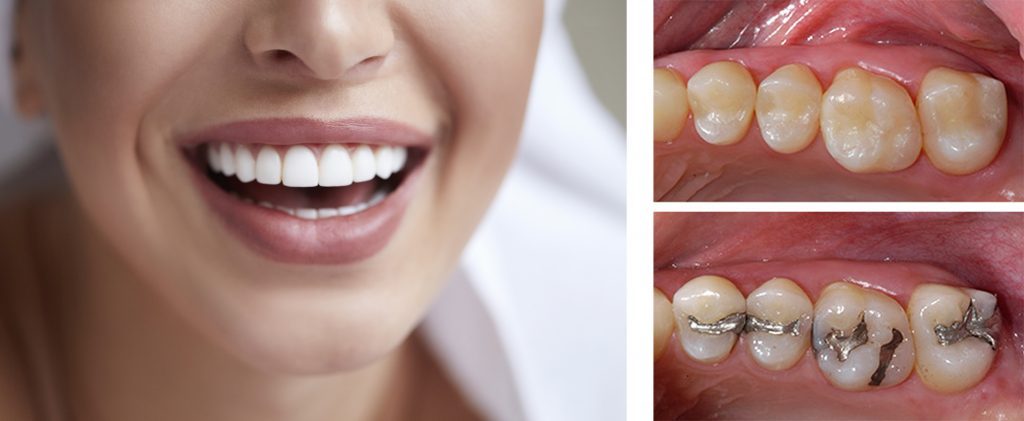
Aesthetic dentistry
For your shiny smile
Beautiful teeth are more than just looks. With sparkling white teeth, we feel confident and attractive. With straight and beautifully shaped front teeth, or with suitable dentures, we can smile broadly again.
A beautiful and natural smile for the patient - that is our goal at the Himmelmann und Kollegen practice. A team of recognized specialists, modern diagnostic tools and individual high-quality laboratory work await you here. All of this combined in a pleasant and personal atmosphere.
We all want a beautiful, aesthetic smile. So-called Veneers are wafer-thin Veneers made of ceramic. Veneers are a very valued procedure in aesthetic dentistry. They are attached to the surface of natural teeth with special glue, mostly on the front teeth.
Discolored and damaged teeth are unsightly. With Veneers front teeth can be corrected gently and over the long term in a very aesthetic way. The natural tooth substance is largely preserved. The Veneers are a maximum of one millimeter thick. Nevertheless, disturbing defects, for example the tooth shape, unevenness, discoloration, small gaps or misalignments that have occurred over the years can be made invisible. A dentist can also bring chipped parts of the tooth - for example due to an accident Veneers often elegantly reconstruct. The advantage is that no valuable tooth substance is damaged, which would be the case with other treatment methods. As a rule, a conventional ceramicVeneer the corresponding tooth lightly ground (0.3 to 0.5 millimeters) so that the veneers do not look unnaturally thick.
Beautiful teeth have to be shiny white. People who have white teeth are generally considered to be healthier. The subconscious suggests to us that people with light white teeth are otherwise physically well-groomed.
Naturally white teeth look aesthetic and attractive, whereas discolored teeth can reduce the appearance. In our practice, we can whiten your teeth gently and clearly in just one session.
We also offer you home bleaching. You can whiten your teeth at home using splints specially made for you using a gentle procedure.
Would you like to part with amalgam fillings in your mouth? From a holistic medical point of view, this is very welcome. We generally advise against leaving the metal alloy amalgam in the mouth or using it at all. It consists of 50 percent toxic mercury and other heavy metals. As a result, chronic inflammation, allergic immune reactions and toxic loads can occur.
When grinding your teeth and also during normal chewing, the smallest microparticles are rubbed off, which can, for example, put a strain on the liver and brain. It also arises regularly Mercury vapor. Symptoms are then for example constant tiredness or pain in the head and limbs. The permanent poisoning has a lasting effect on your health and quality of life. Therefore, we advise under a Metal renovation Have your amalgam removed.
Aesthetic dentistry
For your shiny smile
Beautiful teeth are more than just looks. With sparkling white teeth, we feel confident and attractive. With straight and beautifully shaped front teeth, or with suitable dentures, we can smile broadly again.
A beautiful and natural smile for the patient - that is our goal at the Himmelmann und Kollegen practice. A team of recognized specialists, modern diagnostic tools and individual high-quality laboratory work await you here. All of this combined in a pleasant and personal atmosphere.
We all want a beautiful, aesthetic smile. So-called Veneers are wafer-thin Veneers made of ceramic. Veneers are a very valued procedure in aesthetic dentistry. They are attached to the surface of natural teeth with special glue, mostly on the front teeth.
Discolored and damaged teeth are unsightly. With Veneers front teeth can be corrected gently and over the long term in a very aesthetic way. The natural tooth substance is largely preserved. The Veneers are a maximum of one millimeter thick. Nevertheless, disturbing defects, for example the tooth shape, unevenness, discoloration, small gaps or misalignments that have occurred over the years can be made invisible. A dentist can also bring chipped parts of the tooth - for example due to an accident Veneers often elegantly reconstruct. The advantage is that no valuable tooth substance is damaged, which would be the case with other treatment methods. As a rule, a conventional ceramicVeneer the corresponding tooth lightly ground (0.3 to 0.5 millimeters) so that the veneers do not look unnaturally thick.
Beautiful teeth have to be shiny white. People who have white teeth are generally considered to be healthier. The subconscious suggests to us that people with light white teeth are otherwise physically well-groomed.
Naturally white teeth look aesthetic and attractive, whereas discolored teeth can reduce the appearance. In our practice, we can whiten your teeth gently and clearly in just one session.
We also offer you home bleaching. You can whiten your teeth at home using splints specially made for you using a gentle procedure.
Would you like to part with amalgam fillings in your mouth? From a holistic medical point of view, this is very welcome. We generally advise against leaving the metal alloy amalgam in the mouth or using it at all. It consists of 50 percent toxic mercury and other heavy metals. As a result, chronic inflammation, allergic immune reactions and toxic loads can occur.
When grinding your teeth and also during normal chewing, the smallest microparticles are rubbed off, which can, for example, put a strain on the liver and brain. It also arises regularly Mercury vapor. Symptoms are then for example constant tiredness or pain in the head and limbs. The permanent poisoning has a lasting effect on your health and quality of life. Therefore, we advise under a Metal renovation Have your amalgam removed.

Endodontics
Tooth preservation with the help of modern root canal treatments
The Himmelmann und Kollegen dental practice sees itself as a performance-oriented practice that offers its patients all options for optimal tooth preservation and dentures. In accordance with our philosophy of maximum tooth preservation, root canal treatment or endodontics is an important treatment focus of our practice in Berlin as the last measure before a possible tooth loss. The success rate for root treatments is very high with us - in our eyes endodontics is an indispensable treatment method for this Wellbeing of your teeth. In endodontic root canal treatment, the tooth is opened at one point and the small root canals are freed from irreversibly diseased material, cleaned, disinfected and filled. It will prevent re-inflammation. The tooth is then stabilized - this can often be done with a crown or partial crown, for example.
We are very careful to carry out this treatment painlessly and sensitively, even with severe inflammation, and use the latest techniques for an optimal long-term prognosis.
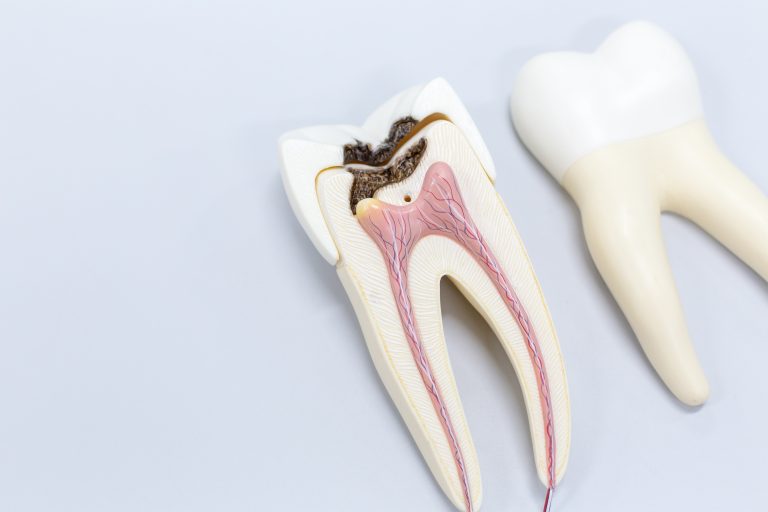
Endodontics
Tooth preservation with the help of modern root canal treatments
The Himmelmann und Kollegen dental practice sees itself as a performance-oriented practice that offers its patients all options for optimal tooth preservation and dentures. In accordance with our philosophy of maximum tooth preservation, root canal treatment or endodontics is an important treatment focus of our practice in Berlin as the last measure before a possible tooth loss. The success rate for root treatments is very high with us - in our eyes endodontics is an indispensable treatment method for this Wellbeing of your teeth. In endodontic root canal treatment, the tooth is opened at one point and the small root canals are freed from irreversibly diseased material, cleaned, disinfected and filled. It will prevent re-inflammation. The tooth is then stabilized - this can often be done with a crown or partial crown, for example.
We are very careful to carry out this treatment painlessly and sensitively, even with severe inflammation, and use the latest techniques for an optimal long-term prognosis.


Pediatric Dentistry
We value effective protection of young teeth
Relaxed and playful - this is how a pediatric dentist should always approach the first dentist visits so that your child feels safe and comfortable. Our goal is a fear and pain-free treatment, so that the visit with us will be fondly remembered.
The range of services of our dental practice in the field of pediatric dentistry ensures comprehensive protection of the milk teeth and the permanent teeth of your children.
We will advise you in detail on what you can do to optimally protect children's teeth in everyday life. We would like to see us as soon as possible from the first tooth eruption and every 6 months. This enables us to accompany you and your child through all phases of the development of the teeth.
Child prophylaxis and seals:
Regular prophylaxis, timely sealing, nutrition and care coaching effectively prevent dental diseases and are particularly important for children. We carefully guide your child so that dental care and the visit to the dentist are completely natural and free of caries.
Pediatric Dentistry
We value effective protection of young teeth
Relaxed and playful - this is how a pediatric dentist should always approach the first dentist visits so that your child feels safe and comfortable. Our goal is a fear and pain-free treatment, so that the visit with us will be fondly remembered.
The range of services of our dental practice in the field of pediatric dentistry ensures comprehensive protection of the milk teeth and the permanent teeth of your children.
We will advise you in detail on what you can do to optimally protect children's teeth in everyday life. We would like to see us as soon as possible from the first tooth eruption and every 6 months. This enables us to accompany you and your child through all phases of the development of the teeth.
Child prophylaxis and seals:
Regular prophylaxis, timely sealing, nutrition and care coaching effectively prevent dental diseases and are particularly important for children. We carefully guide your child so that dental care and the visit to the dentist are completely natural and free of caries.

High quality dentures
For a good quality of life
Dentures are a core competence of our practice. Our goal is a long-lasting supply according to the most modern aesthetic and functional aspects.
A high-quality denture that is well adapted to your bite ensures a natural chewing sensation, helps avoid TMJ problems and is simply more durable. In addition, dentures no longer have to attract attention.
If there is a defect with a larger extent, it is necessary to replace the tooth with a inlay, one Partial crown or Full crown to stabilize. After the impression has been taken, these are made of individually layered ceramic or gold.
At fixed dentures one or more teeth are ground and then fitted with a crown or bridge. A tooth crown is used for teeth that are severely weakened by a defect and which can be stabilized accordingly by a crown restoration. If a tooth is missing, it can be replaced with a Bridge, which is attached to the adjacent teeth, must be replaced. Bridges and crowns can be made of either metal or ceramic.
If a large number of teeth are missing, a removable dentures, a prosthesis, is necessary. The prosthesis is attached to the remaining teeth with special crowns. It is a so-called Partial denture. In cases where there are no more teeth and therefore all teeth have to be replaced, one speaks of one Full denture.
The aim of prosthetics is not only the replacement of lost teeth but also the optimal restoration of form, function, aesthetics and chewing comfort.
This type of reconstruction is known and loved around the world under the name "German Crown". The manufacture of the secondary crowns by means of electroplating allows the two crowns to slide against each other with almost no wear. This minimizes friction and maintains long-term hydraulic adhesion.
The attachment prosthesis is one of the combined, non-fixed dentures. The removable part consists of a metal-reinforced partial prosthesis high quality plastic.
The attachment itself is a Connector system, which is used to attach the dental prosthesis to the existing teeth. A part (matrix) is attached to the prosthesis, the counterpart (Patrix) on the abutment teeth, i.e. on the edge teeth of the tooth gap to be replaced.
The dentist attaches the attachment to the existing teeth by crowning the tooth and incorporating the attachment. In contrast to the clasp prosthesis, the Attachment of the attachment from the front invisible. In order to increase the durability of the abutment teeth, one often also crowns the neighboring tooth or teeth in order to connect them to one another and thus achieve greater stability. This protects the retaining teeth from the pressure and lever forces that act when wearing and using the attachment prosthesis.
The attachment prosthesis usually replaces missing teeth on both sides of the jaw. In that case the plastic base of the prosthesis is stabilized with a connector. How exactly this is designed depends on the respective dental situation.
Dental implants are artificial tooth roots made of titanium on which dental crowns, dental bridges, telescopic prostheses or bar prostheses are anchored.
In these cases, too, the long-term durability and the perfect appearance of your teeth is the top priority for our dental practice Himmelmann and colleagues.
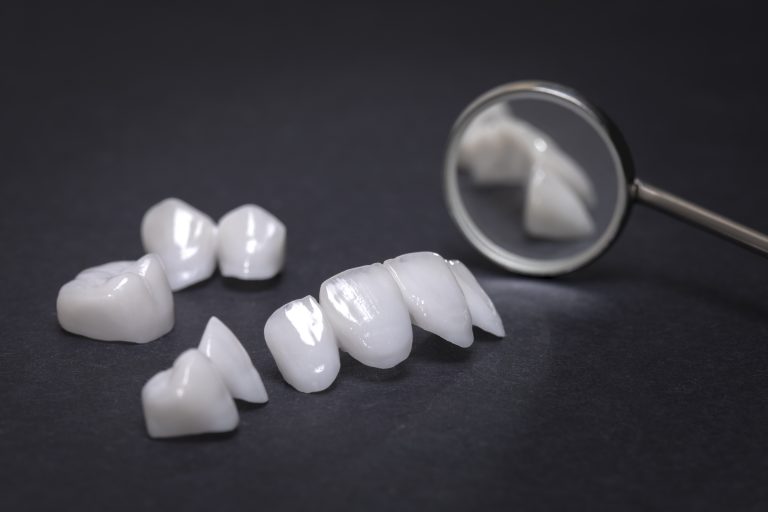
High quality dentures
For a good quality of life
Dentures are a core competence of our practice. Our goal is a long-lasting supply according to the most modern aesthetic and functional aspects.
A high-quality denture that is well adapted to your bite ensures a natural chewing sensation, helps avoid TMJ problems and is simply more durable. In addition, dentures no longer have to attract attention.
If there is a defect with a larger extent, it is necessary to replace the tooth with a inlay, one Partial crown or Full crown to stabilize. After the impression has been taken, these are made of individually layered ceramic or gold.
At fixed dentures one or more teeth are ground and then fitted with a crown or bridge. A tooth crown is used for teeth that are severely weakened by a defect and which can be stabilized accordingly by a crown restoration. If a tooth is missing, it can be replaced with a Bridge, which is attached to the adjacent teeth, must be replaced. Bridges and crowns can be made of either metal or ceramic.
If a large number of teeth are missing, a removable dentures, a prosthesis, is necessary. The prosthesis is attached to the remaining teeth with special crowns. It is a so-called Partial denture. In cases where there are no more teeth and therefore all teeth have to be replaced, one speaks of one Full denture.
The aim of prosthetics is not only the replacement of lost teeth but also the optimal restoration of form, function, aesthetics and chewing comfort.
This type of reconstruction is known and loved around the world under the name "German Crown". The manufacture of the secondary crowns by means of electroplating allows the two crowns to slide against each other with almost no wear. This minimizes friction and maintains long-term hydraulic adhesion.
The attachment prosthesis is one of the combined, non-fixed dentures. The removable part consists of a metal-reinforced partial prosthesis high quality plastic.
The attachment itself is a Connector system, which is used to attach the dental prosthesis to the existing teeth. A part (matrix) is attached to the prosthesis, the counterpart (Patrix) on the abutment teeth, i.e. on the edge teeth of the tooth gap to be replaced.
The dentist attaches the attachment to the existing teeth by crowning the tooth and incorporating the attachment. In contrast to the clasp prosthesis, the Attachment of the attachment from the front invisible. In order to increase the durability of the abutment teeth, one often also crowns the neighboring tooth or teeth in order to connect them to one another and thus achieve greater stability. This protects the retaining teeth from the pressure and lever forces that act when wearing and using the attachment prosthesis.
The attachment prosthesis usually replaces missing teeth on both sides of the jaw. In that case the plastic base of the prosthesis is stabilized with a connector. How exactly this is designed depends on the respective dental situation.
Dental implants are artificial tooth roots made of titanium on which dental crowns, dental bridges, telescopic prostheses or bar prostheses are anchored.
In these cases, too, the long-term durability and the perfect appearance of your teeth is the top priority for our dental practice Himmelmann and colleagues.

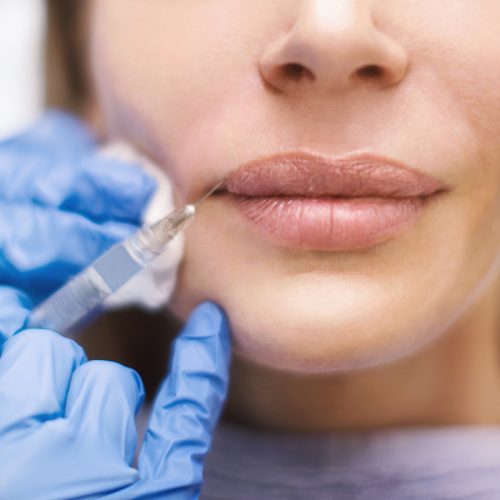
Lip augmentation and lip correction with hyaluronic acid
Full lips together with healthy, beautiful teeth for a perfect smile
Regularly curved and full lips with clear contours appear sensual and seductive. Lip injection with hyaluronic acid is an effective method with which the lips can be changed in shape and size according to the wishes of the patient. If you have your Splash on lips we would like to clarify the possibilities of the Lip injection on.
Lip augmentation with hyaluronic acid is a classic treatment in the field of lip correction. The use of the body's own substance hyaluronic acid has been very well tested in this area. In the Himmelmann und Kollegen practice, we only work with product providers from the premium segment in order to achieve the long-term and beautiful result possible for our patients. The hyaluronic acid is injected into the lip with very fine cannulas in different places, so that even padding can be achieved. However, the result is temporarily limited to six to twelve months, as hyaluronic acid is broken down by the body after a while.
Lip augmentation and lip correction with hyaluronic acid
Full lips together with healthy, beautiful teeth for a perfect smile
Regularly curved and full lips with clear contours appear sensual and seductive. Lip injection with hyaluronic acid is an effective method with which the lips can be changed in shape and size according to the wishes of the patient. If you have your Splash on lips we would like to clarify the possibilities of the Lip injection on.
Lip augmentation with hyaluronic acid is a classic treatment in the field of lip correction. The use of the body's own substance hyaluronic acid has been very well tested in this area. In the Himmelmann und Kollegen practice, we only work with product providers from the premium segment in order to achieve the long-term and beautiful result possible for our patients. The hyaluronic acid is injected into the lip with very fine cannulas in different places, so that even padding can be achieved. However, the result is temporarily limited to six to twelve months, as hyaluronic acid is broken down by the body after a while.

prophylaxis
Your thorough preventive care for optimal dental and gum health
Prophylaxis is the most important component of your dental health, because a clean tooth stays healthy longer. Proper dental care is therefore an important point in maintaining your health. It is particularly important to us to support you with optimal care and thus with the preservation of your own, healthy teeth. We therefore recommend that you every 6 months to have the prophylaxis carried out if you are going to visit your trusted dentist for the six-month check-up anyway.

prophylaxis
Your thorough preventive care for optimal dental and gum health
Prophylaxis is the most important component of your dental health, because a clean tooth stays healthy longer. Proper dental care is therefore an important point in maintaining your health. It is particularly important to us to support you with optimal care and thus with the preservation of your own, healthy teeth. We therefore recommend that you every 6 months to have the prophylaxis carried out if you are going to visit your trusted dentist for the six-month check-up anyway.

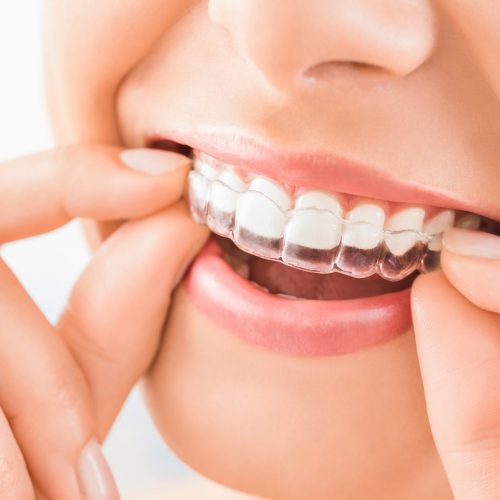
Gnash splints
For a life without worn teeth and craniomandibular dysfunction
Gnash splints
For a life without worn teeth and craniomandibular dysfunction

Periodontal Treatment
For firm, painless teeth and healthy tooth supporting structures
Current studies show: 53% of adults suffer from moderate periodontitis and 21% even from one severe Shape. For seniors 48% are affected by moderate and 40% by severe illness.
If an inflammation of the gums, so-called gingivitis, is detected early, healing can be brought about in a short time with relatively simple treatment methods.
If there is already periodontitis (= inflammation of the bony gums), early detection is also important here, because the more severe the disease, the bony supporting tissue is irreversibly destroyed and its treatment becomes more difficult.
At the Himmelmann und Kollegen practice, we offer you a comprehensive, scientifically sound concept for the treatment of periodontal disease, which includes the following treatment phases:
1. Structured periodontal or gum treatment consisting of 4 phases:
- Pretreatment: Carrying out a professional teeth cleaning, individual instruction in an adapted oral hygiene and control of the inflammation
- The actual treatment, so-called anti-infectious periodontal therapy
- Follow-up care and wound healing
- Control of the success of the treatment, so-called reevaluation
2. If necessary, surgical therapy, if indicated, tissue build-up with bone regeneration using enamel matrix proteins
3. Always: lifelong supportive periodontal therapy to ensure the success of the treatment
4. And if the neck of the tooth is exposed: Coverage of exposed necks of the tooth and gum recessions
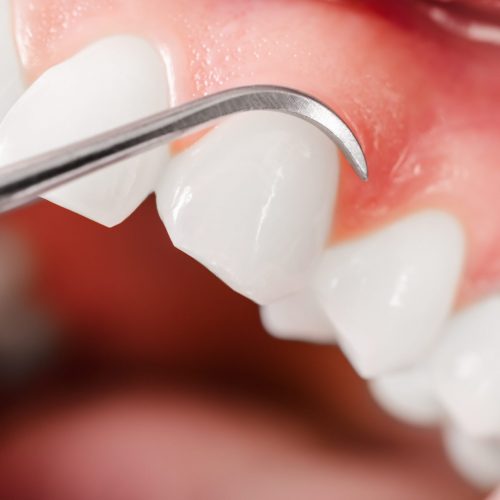
Periodontal Treatment
For firm, painless teeth and healthy tooth supporting structures
Current studies show: 53% of adults suffer from moderate periodontitis and 21% even from one severe Shape. For seniors 48% are affected by moderate and 40% by severe illness.
If an inflammation of the gums, so-called gingivitis, is detected early, healing can be brought about in a short time with relatively simple treatment methods.
If there is already periodontitis (= inflammation of the bony gums), early detection is also important here, because the more severe the disease, the bony supporting tissue is irreversibly destroyed and its treatment becomes more difficult.
At the Himmelmann und Kollegen practice, we offer you a comprehensive, scientifically sound concept for the treatment of periodontal disease, which includes the following treatment phases:
1. Structured periodontal or gum treatment consisting of 4 phases:
- Pretreatment: Carrying out a professional teeth cleaning, individual instruction in an adapted oral hygiene and control of the inflammation
- The actual treatment, so-called anti-infectious periodontal therapy
- Follow-up care and wound healing
- Control of the success of the treatment, so-called reevaluation
2. If necessary, surgical therapy, if indicated, tissue build-up with bone regeneration using enamel matrix proteins
3. Always: lifelong supportive periodontal therapy to ensure the success of the treatment
4. And if the neck of the tooth is exposed: Coverage of exposed necks of the tooth and gum recessions

Do you have any questions about our practice or the position?
Just give us a call or email us, we will be happy to help you.